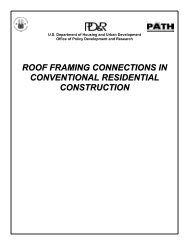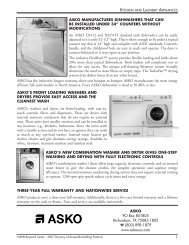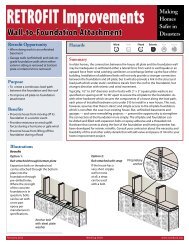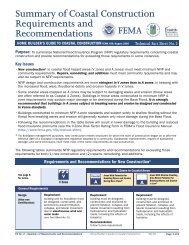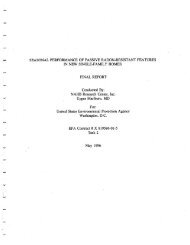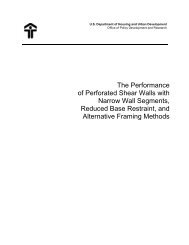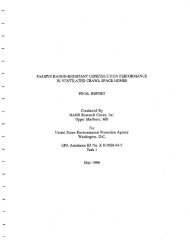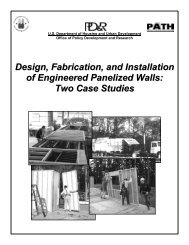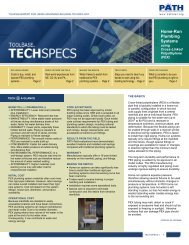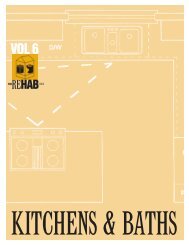The Rehab Guide, Volume 2: Exterior Walls - ToolBase Services
The Rehab Guide, Volume 2: Exterior Walls - ToolBase Services
The Rehab Guide, Volume 2: Exterior Walls - ToolBase Services
You also want an ePaper? Increase the reach of your titles
YUMPU automatically turns print PDFs into web optimized ePapers that Google loves.
TECHNIQUES, MATERIALS, TOOLSOf the innumerable possible combinations of insulating materials and wall configuration, the following listcovers those in common use and uncommon systems that are recommended.1. INSTALL BATT INSULATION.Fiberglass insulation is available in batt form, typically sized 93 inches long to fit within the stud-space of an8-foot wall, or in continuous rolls. Both forms are here referred to as “batt insulation.” It is available in manythicknesses, densities and in widths to fit framing at 16-inch and 24-inch centers. Unfaced batts can easily becut to fit into odd-sized spaces, and are preferred where a continuous membrane vapor retarder is installed.Residential batts are available faced with kraft-paper and aluminum foil, and commercial batts with a flameresistantfoil facing are available. All have extended tabs on the facings to secure them in place. When properlyapplied, the facings create a partial vapor retarder. Only unfaced or fire-retardant-faced batts can be leftexposed in attics or occupied spaces. If not accurately cut around wiring and other obstacles, faced batts createlarge air cavities that compromise their effectiveness. Tabs can be “inset stapled“ to the sides of the studs,or “face stapled” to the inner face (Fig. 2). Face stapling is preferred because it creates a better vaporretarder and avoids the air cavity left between the facing and the wall finish when inset stapling. Unless thiscavity is carefully sealed at the top and bottom, it can compromise the wall’s air-tightness and R-value. Staplesinto stud faces must be fully set to avoid interfering with drywall installation. In a three-sided wall cavity, friction-fitunfaced batts, covered with a separate vapor retarder, will typically result in a more effective installationthan will stapled faced batts. In an open wall, the facings are usually necessary for attachment.ADVANTAGES: An economical, flexible, and well-known product. Provides a dependable thickness of uniformdensity and does not settle, if properly installed. Faced batts can insulate an open stud wall.DISADVANTAGES: Effectiveness requires careful installation to avoid gaps and consequent convectivelosses. Glass fibers can be irritating if touched or inhaled.FIGURE 2 FACE STAPLED INSET STAPLED2. INSTALL ENCAPSULATED FIBERGLASS INSULATION.Fiberglass insulation is available in rolls or batts, encapsulated with kraft paper or plastic to reduce mechanicalirritation to installers. <strong>The</strong>se can be used in any installation where batts are appropriate. One face isextended to form attachment tabs. <strong>The</strong> faces on sound control batts do not have a vapor retarder; and someexterior wall batts have a polyethylene vapor retarder on the flange side. Some encapsulated batts have a ClassA fire-rating and can be left exposed if allowed by local codes. Owens Corning markets Miraflex, made fromloose, virtually itch-free glass fibers with no binder, contained in a plastic sleeve. Cutting encapsulated battsaround obstructions is possible, but exposes the fiberglass. Cutting Miraflex releases the fibers; the product40



